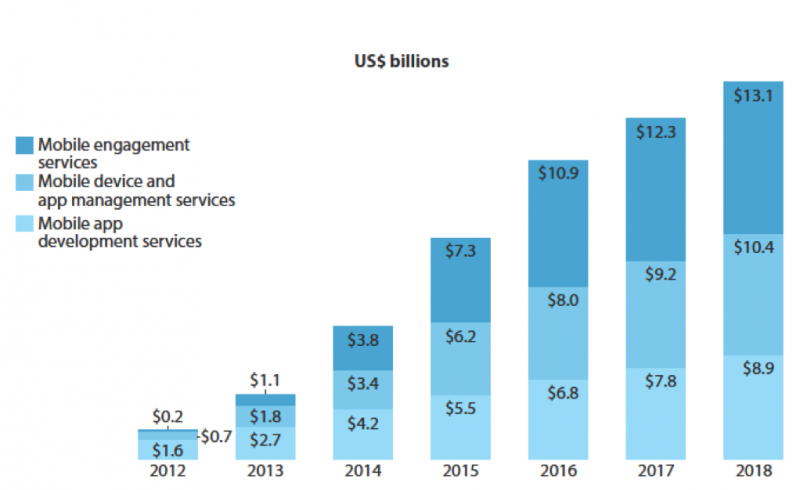Mobile Engagement Providers Are A New $32.4 Billion Market By 2018
My colleague and friend John McCarthy and I have just published a new report on the emergence of a new category of vendors we call “mobile engagement providers” that help firms build excellent mobile experiences. I’ll unpack the report in a series of posts over the next few weeks. You can also read a lengthy post in the Wall Street Journal highlighting the report and Forrester clients can read the full report.
++++++++++++++++++++++++++++
Building and delivering great mobile experiences will be the beating heart of your customer engagement strategy for the next 10 years. The challenge of making a simple, intuitive app that fronts a complex system of engagement will stretch the abilities and swamp the resources of most firms. For help, firms increasingly turn to vendors that possess a connected portfolio of engagement competencies and management skills.
The result will be a new market for mobile engagement providers that will grow to $32.4 billion by 2018 (see the Figure 1). No vendor can do all of this today, but suppliers from six categories — digital agencies, management consultancies, mobile specialists, product development specialists, systems integrators, and telcos — are chasing the prize. The payoff for vendors that make this investment will be to earn a seat at your table as a long-term partner in your engagement success.
Version one of your mobile app was just a standalone pretty face. But in versions two, three, and four, your mobile app will be the new face of systems of engagement, with a goal of helping people “take action in their immediate context and moments of need.”
Fulfilling this mission – and reaping the benefits of a close service connection to your customers and employees – means solving a much bigger problem than shrinking down your Web site or screen-scraping your SAP system. It means serving customers and employees whose minds have shifted to expect anything, anywhere, at any time. If version one of the app cost $250,000, it’s not unusual for version two to cost $2 million.
You’ll spend that money deciphering what your customers really want to do on the mobile devices then building dramatically simplified mobile experiences on complex systems of engagement. You’ll also re-engineer your core processes, systems, and products to help people in their “mobile moments.”
This new $32.4 billion market is comprised of three kinds of services:
- Mobile engagement services: This includes the complex services for building a full system of engagement: ethnographic research, experience design, mobile strategy, business process re-engineering, redesigning middleware, analytics, system consolidation, and upgrades to back-end services. Cloud delivery, third-party services, and platform operations are not included.
- Mobile device and app management services: This includes the per-device fees for managing devices and the apps that run on them: mobile device management and mobile app management. It could include the setup and management of a corporate app store to manage app and policy updates. It does not include monthly telecom or wireless broadband expenses.
- Mobile app development services: This includes developing and maintaining native and hybrid apps for smartphones and tablets as well as mobile websites, including responsive design. It also includes using existing APIs to provide connections to the back-end systems. It does not include experience design.
Next up, we’ll use a story to illustrate what makes simple mobile experiences so complex and what capabilities you and your mobile engagement providers need to succeed. In future posts, we’ll also tell your stories of mobile engagement if you’ll share them.
Figure 1 Mobile Services Will Soar Globally To $32.4 Billion By 2018

